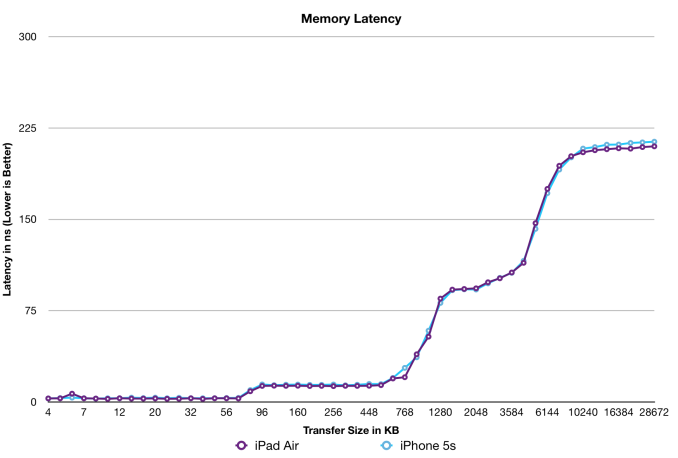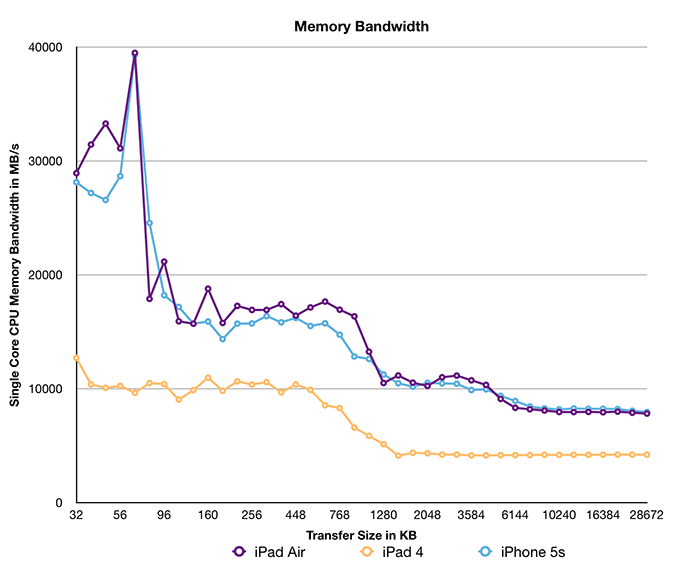The iPad Air Review
by Anand Lal Shimpi on October 29, 2013 9:00 PM ESTAn Update on Apple’s A7: It's Better Than I Thought
When I reviewed the iPhone 5s I didn’t have much time to go in and do the sort of in-depth investigation into Cyclone (Apple’s 64-bit custom ARMv8 core) as I did with Swift (Apple’s custom ARMv7 core from A6) the year before. I had heard rumors that Cyclone was substantially wider than its predecessor but I didn’t really have any proof other than hearsay so I left it out of the article. Instead I surmised in the 5s review that the A7 was likely an evolved Swift core rather than a brand new design, after all - what sense would it make to design a new CPU core and then do it all over again for the next one? It turns out I was quite wrong.
Armed with a bit of custom code and a bunch of low level tests I think I have a far better idea of what Apple’s A7 and Cyclone cores look like now than I did a month ago. I’m still toying with the idea of doing a much deeper investigation into A7, but I wanted to share some of my findings here.
The first task is to understand the width of the machine. With Swift I got lucky in that Apple had left a bunch of public LLVM documentation uncensored, referring to Swift’s 3-wide design. It turns out that although the design might be capable of decoding, issuing and retiring up to three instructions per clock, in most cases it behaved like a 2-wide machine. Mix FP and integer code and you’re looking at a machine that’s more like 1.5 instructions wide. Obviously Swift did very well in the market and its competitors at the time, including Qualcomm’s Krait 300, were similarly capable.
With Cyclone Apple is in a completely different league. As far as I can tell, peak issue width of Cyclone is 6 instructions. That’s at least 2x the width of Swift and Krait, and at best more than 3x the width depending on instruction mix. Limitations on co-issuing FP and integer math have also been lifted as you can run up to four integer adds and two FP adds in parallel. You can also perform up to two loads or stores per clock.
I don’t yet have a good understanding of the number of execution ports and how they’re mapped, but Cyclone appears to be the widest ARM architecture we’ve ever seen at this point. I’m talking wider than Qualcomm’s Krait 400 and even ARM’s Cortex A15.
I did have some low level analysis in the 5s review, where I pointed out the significantly reduced memory latency and increased bandwidth to the A7. It turns out that I was missing a big part of the story back then as well…
A Large System Wide Cache
In our iPhone 5s review I pointed out that the A7 now featured more computational GPU power than the 4th generation iPad. For a device running at 1/8 the resolution of the iPad, the A7’s GPU either meant that Apple had an application that needed tons of GPU performance or it planned on using the A7 in other, higher resolution devices. I speculated it would be the latter, and it turns out that’s indeed the case. For the first time since the iPad 2, Apple once again shares common silicon between the iPhone 5s, iPad Air and iPad mini with Retina Display.
As Brian found out in his investigation after the iPad event last week all three devices use the exact same silicon with the exact same internal model number: S5L8960X. There are no extra cores, no change in GPU configuration and the biggest one: no increase in memory bandwidth.
Previously both the A5X and A6X featured a 128-bit wide memory interface, with half of it seemingly reserved for GPU use exclusively. The non-X parts by comparison only had a 64-bit wide memory interface. The assumption was that a move to such a high resolution display demanded a substantial increase in memory bandwidth. With the A7, Apple takes a step back in memory interface width - so is it enough to hamper the performance of the iPad Air with its 2048 x 1536 display?
The numbers alone tell us the answer is no. In all available graphics benchmarks the iPad Air delivers better performance at its native resolution than the outgoing 4th generation iPad (as you'll soon see). Now many of these benchmarks are bound more by GPU compute rather than memory bandwidth, a side effect of the relative lack of memory bandwidth on modern day mobile platforms. Across the board though I couldn’t find a situation where anything was smoother on the iPad 4 than the iPad Air.
There’s another part of this story. Something I missed in my original A7 analysis. When Chipworks posted a shot of the A7 die many of you correctly identified what appeared to be a 4MB SRAM on the die itself. It's highlighted on the right in the floorplan diagram below:

A7 Floorplan, Courtesy Chipworks
While I originally assumed that this SRAM might be reserved for use by the ISP, it turns out that it can do a lot more than that. If we look at memory latency (from the perspective of a single CPU core) vs. transfer size on A7 we notice a very interesting phenomenon between 1MB and 4MB:
That SRAM is indeed some sort of a cache before you get to main memory. It’s not the fastest thing in the world, but it’s appreciably quicker than going all the way out to main memory. Available bandwidth is also pretty good:
We’re only looking at bandwidth seen by a single CPU core, but even then we’re talking about 10GB/s. Lookups in this third level cache don’t happen in parallel with main memory requests, so the impact on worst case memory latency is additive unfortunately (a tradeoff of speed vs. power).
I don’t yet have the tools needed to measure the impact of this on-die memory on GPU accesses, but in the worst case scenario it’ll help free up more of the memory interface for use by the GPU. It’s more likely that some graphics requests are cached here as well, with intelligent allocation of bandwidth depending on what type of application you’re running.
That’s the other aspect of what makes A7 so very interesting. This is the first Apple SoC that’s able to deliver good amounts of memory bandwidth to all consumers. A single CPU core can use up 8GB/s of bandwidth. I’m still vetting other SoCs, but so far I haven’t come across anyone in the ARM camp that can compete with what Apple has built here. Only Intel is competitive.












444 Comments
View All Comments
sna2 - Wednesday, October 30, 2013 - link
wrong.Most flash sticks are eMMC and they operate at 100MB/s to 200MB/s which needs usb3.
Kristian Vättö - Wednesday, October 30, 2013 - link
Read speeds can easily exceed 100MB/s because reading from NAND is much faster than writing to it. Write speeds of 32GB or smaller flash devices can barely hit 40MB/s because the NAND itself can't write faster, and it's the write speeds that matter when syncing. Even if we're dealing with a full blown SATA SSD the write performance for 32GB models is around 40MB/s. Performance does scale with capacity so a 64GB or 128GB model will be faster but we are still far away from data rates over 100MB/s.fokka - Wednesday, October 30, 2013 - link
this, so much. i'm always astounded when people bring up that they wanna see (e.g.) usb3 in their next mobile device. as if there are any current devices scratching on the 30MB-mark which would be totally possible with usb2, if manufacturers wouldn't insist on implementing bargain-bin nand and even shittier usb-controllers.FCsean - Wednesday, October 30, 2013 - link
It would be stupid of them to put thunderbolt cables for iOS devices since more than half of the owners don't own a mac. USB 3.0 would be the way to go but not everyone has USB 3.0 so they're not yet wasting their money in manufacturing USB 3.0 cables since it's a lot more expensive to manufacture. I think it's two times more expensive.darkcrayon - Wednesday, October 30, 2013 - link
Not only that, but am I the only one who rarely syncs large amounts of data at a time anymore with an iPad? Most of the sync is done wirelessly in small amounts over time. The only time I need a full many gig sync is when I upgrade devices or (extremely rarely) need to do a full wipe. Faster syncing would be nice but it's just not the daily process it used to be.Sushisamurai - Wednesday, October 30, 2013 - link
...yeah.... I don't know about u guys, but is wireless sync all the time now, either comp to iPad or iPad OTA with iCloud, wiping my device q3-6 months. I have no issues with restoring a full 32GB, and it's pretty quick... Down speeds of 10MB/s wifi, 40MB/s LTE (OTA for both), but if I were to sync via comp, a HDD to NAND is pretty abysmal speeds. Not to mention, if it was TB/USB3 u're going to have a thickness increase, and I'd rather not. Inductive charging, if u recall, is a slow, inefficient form of charging. I'd rather have my full 2A going into my iPad versuses drawing the same 12W but giving me the equivalent of 6W wirelessly. NFC and tablets? Okayyyyyyyy there.petersellers - Wednesday, October 30, 2013 - link
Doubly stupid considering that thunderbolt runs on PCI express lanes and PCI express is not present in any of these devicesekotan - Wednesday, October 30, 2013 - link
You can't have Thunderbolt without a corresponding Intel chipset, so forget about it on any ARM tablet. Also, the NAND used by these devices is so slow that having Thunderbolt would be utterly pointless. Most can't even saturate USB 2.0, never mind USB 3.0. Only the most recent Apple mobile devices have NAND fast enough to saturate USB 2.0.abazigal - Saturday, November 2, 2013 - link
I restored my 5s recently (coming from a 32gb 4s). The whole process took 1-2 minutes at most. Just plug in and click a button. Likewise, few people are so fastidious as to back up their devices via iTunes manually every day. The time savings from going thunderbolt is so minimal that unless your life somehow revolves around restoring thousands of these devices every day, I don't feel the benefits are worth the added cost.iSayuSay - Sunday, November 3, 2013 - link
And how Thunderbolt sync would help? Did you realize how much is the transfer rate from NAND flash in the iPad/iPhone? No more than 16MB/s, it's not SSD per say. It's a slow internal memory it becomes bottleneck. So as long as Apple do not change those (I doubt it will ever for the next 5 years), there's no point of porting Lightning to Thunderbolt or even USB 3.0 .. Ever.